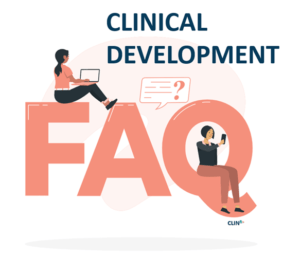Clinical Development FAQ

Q: What is a Clinical Development Plan (CDP) under the EU MDR?
A: A Clinical Development Plan (CDP) is a strategic document required by the EU Medical Devices Regulation (MDR). It outlines the progression of a medical device’s development, starting from preliminary research (e.g., first-in-man studies, feasibility research, pilot studies) and leading to conclusive research, including pivotal clinical investigations and Post Market Clinical Follow-up (PMCF). The CDP includes milestones and prospective acceptance criteria, aligning development and regulatory requirements.
Q: Why is a Clinical Development Plan important?
A: The CDP serves as a valuable tool for aligning development and regulatory requirements. It helps manufacturers establish a strategic approach to their product development by outlining the intended use, patient population, intended user, intended environment, and key operational principles of the medical device. The CDP ensures coordination among different business functions and outlines the contributions required from each department to obtain CE marking, establish clinical claims, and facilitate market entry.
Q: Is the CDP a standalone document?
A: The CDP is not intended to be a standalone document. Instead, it serves as a core document that unifies different business processes and outlines the contributions of each department in obtaining the CE mark, accessing markets, and maintaining competitiveness. It helps align essential business functions towards a common goal.
Q: What is the importance of terminology in the CDP?
A: Terminology is crucial in regulatory contexts, and accurate translation and interpretation are essential for compliance and audit purposes. Consistency in terminology and understanding helps in the efficient translation of information from pre-existing CE marks, facilitating market access. By ensuring effective translation, manufacturers can focus on addressing any gaps to comply with the General Safety and Performance Requirements (GSPR) of the MDR.
Q: How does the CDP differ for new and existing medical devices?
A: For new devices that require clinical evidence to be compiled, the CDP outlines the progression from pre-clinical data to pivotal studies necessary to support the CE mark application. For existing devices that have already been certified, the CDP focuses on managing post-market clinical follow-up (PMCF) and includes milestones and acceptance criteria in the PMCF plan.
Q: What is the role of clinical/performance data in the CDP?
A: Manufacturers should actively monitor the performance, effectiveness, and safety of the device throughout its lifecycle. The CDP should specify how future product releases or claims will be handled to ensure the availability of necessary clinical data. Post-market information, such as complaints, PMCF/PMPF data, real-world performance data, end-user feedback, and published research/guidelines, should be considered and included in the clinical evaluation process.
Q: How can real-world performance data be utilized in the CDP?
A: Real-world performance data, facilitated by the connectivity of the Medical Device Software (MDSW), can provide insights for timely detection and correction of malfunctions, identification of systematic misuse, understanding user interactions, ongoing monitoring of clinical performance, enhancing effectiveness, and developing claims in the CDP or future releases. Real-world performance data contributes to a deeper understanding of the device’s functionalities and potential uses.
Q: Are there any obligations for devices with existing CE marking?
A: The CDP remains relevant for devices that have already obtained CE marking under the MDR. It provides valuable insights for post-market surveillance (PMS), including justification for the PMCF plan and potential future indications that the manufacturer may pursue.



